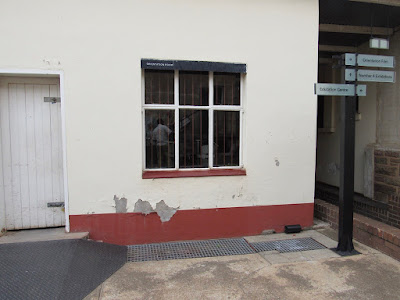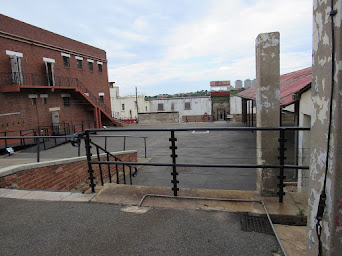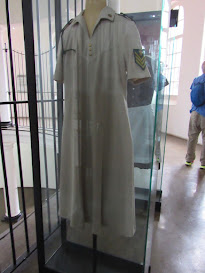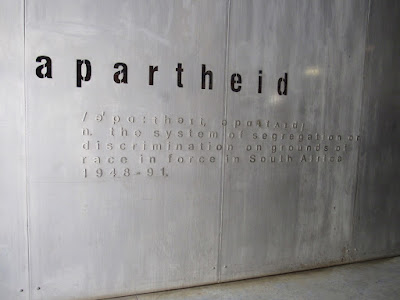Johannesburg is a modern city like any modern city: dense population, skyscrapers, lots of traffic, lots of money flowing through it. But the history of this town surpasses most as an icon of suppression and subsequent freedom for a non-white majority that lives here. One of the worst examples of suppression is Prison Number Four that housed criminals and political prisoners alike. Mandela served time here as did Mahatma Gandhi. Conditions were horrible beyond belief. And yet, the 1990s would see a dramatic change that would reverse all that had gone on before, namely, the end of apartheid. The prison would become Constitutional Hill where a beacon of truth and justice were guaranteed for all people not only of Johannesburg, but South Africa itself.
Black People and Prison
Prisons like Number Four were part of a system of maintaining racial discrimination during the apartheid era. Going to prison was part of everyday life for black people. People whose only crime was they were black would be thrown together with thieves, rapists, and murderers. In1960, one in eight of the black population was convicted. This turned innocent people into criminals. Some became political activists in prison.
"Racism, one of the great evils of our time, bedevils human relations, between individuals, within and between nations and across continents. It brutalizes entire peoples, destroys persons, warps the process of thought and injects into human society a foul air of tension, mutual antagonism and hatred."
Oliver Tambo, former president of the African National Congress
Prison Number Four
This is section Four and Five of the Old Fort Prison Complex, commonly known as Number Four. The original 'Native Jail' was built on this site between 1902 and 1904 to house black make prisoners. Because of its location in the inner city, the Johannesburg City Council planned to move it to a more suitable location. However, it was only closed in 1983. From the beginning, the prison was overcrowded. At times, tents were erected in the yards to accommodate new prisoners. In 1953, Number Four had a capacity of 979 but it held 2,207 prisoners. Cells designed to hold 30 prisoners often held up to 60. In contrast,White prisoners in the Old Fort were kept in smaller cells, usually on their own.
"We knew Number Four to be a very scary place, like going down a mine, because when the police car arrived at the reception, you used to go deep down, deep, deep into the earth." Sipho Sibiya, prisoner, 1960
Number Four was once home to prisoners such as Mahatma Gandhi, Robert Sobukwe (an anti-apartheid revolutionary and founding member of the Pan Africanist Congress who served as the first president of the organization) and the students of the 1976 Soweto uprising.
Entrance to a communal cell
Overcrowding was a constant problem in Number Four. These communal cells often housed twice the number of prisoners they were designed for. While the cells may have appeared chaotic, they were highly organized spaces run by cell bosses. Strict hierarchies divided the prisoners, whose social power and status determined where and how they slept as well as what they could and could not do in the cells.
The bosses slept furthest from the toilets. They robbed other prisoners of their blankets and personal belongings to create comfort, space, and privacy for themselves.
The emaphanga was an area reserved for the sakabams, the bosses' lieutenants, who used violence and intimidation to control the cell. The besoekers also slept here. They used the goods they received from visitors to buy the privilege of sleeping in this area. The besoekers were easily demoted if their visits stopped.
The "specials" or cleaners, whose role it was to serve the bosses, slept between the toilet and the mapanga in and area called the "bush".
The Gubudweni was the most overcrowded and cramped space in the cell. Prisoners slept head to toe 'like sardines'. These underlings did not have anything to trade for comfort or privilege or they were simply the newcomers in the cell. They could only be promoted by proving they were part of a prison gang or by fighting on behalf of the sakabams or fighting the sakabams themselves.

According to the Minister of Prisons, 1970
White prisoners have:
a divan (or 2 sleeping mats if floor space is limited)
a mattress, pillow, and bedspread
3 blankets
4 sheets
2 pillowcases
Non-whites have: 2 sleeping mats and 3 blankets
Dining
 "The whites ate as if they were at a restaurant where you look at the menu and choose what you want. Their menu was not the same everyday. They ate better food than the owners of the country. For black people, there was nothing like that. They ate rubbish." Martin 'Panyaza' Shabangu, prison warder, 1973-80
"The whites ate as if they were at a restaurant where you look at the menu and choose what you want. Their menu was not the same everyday. They ate better food than the owners of the country. For black people, there was nothing like that. They ate rubbish." Martin 'Panyaza' Shabangu, prison warder, 1973-80 "If you did something wrong in prison, like not shaving your head, you were punished by being put in the ekhulukhuthu (isolation cells) for the day and you were denied three meals. We called this punishment 'drie maal tye' (three times a day). When the guard opens the next day, you are so weak that your knees are wobbly. You can't even make it to your porridge." Jack Mabaso, prisoner cell boss, 1967-83
"If you did something wrong in prison, like not shaving your head, you were punished by being put in the ekhulukhuthu (isolation cells) for the day and you were denied three meals. We called this punishment 'drie maal tye' (three times a day). When the guard opens the next day, you are so weak that your knees are wobbly. You can't even make it to your porridge." Jack Mabaso, prisoner cell boss, 1967-83
White prisoners: 1 lb. pudding or cake
Non-white prisoners: one pint coffee or tea with one ounce of sugar, milk if available from ordinary supply, may be given
 The prison was a health hazard. Over the year, there were outbreaks of diseases like Enteric Fever and Typhoid. Hospital facilities were inadequate and doctors were present for only part of the day.
The prison was a health hazard. Over the year, there were outbreaks of diseases like Enteric Fever and Typhoid. Hospital facilities were inadequate and doctors were present for only part of the day.Jan 10-30, 1908 Arrested for failing to register or to leave Transvaal
October 7, 1908 Imprisonment and hard labor for not having his registration, which he burned
Feb - May, 1909 Imprisonment at Transvaal for not having registration certificate
Nov 6-7, 1913 Arrested for conducting the "Great March" and out on bail
Nov 8, 1913 Arrested again and released on bail
Nov 9 - Dec 18, 1913 Arrested and sentenced to 9 months imprisonment but unexpectedly releasedNelson Mandela and the Old Fort
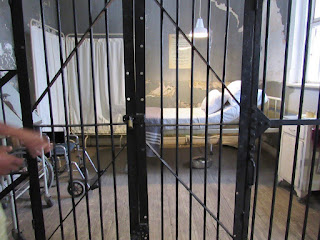 This is the hospital ward where Nelson Mandela stayed during his second incarceration at the Old Fort in 1962. He was considered to risky to be among the other prisoners, so he was isolated from them. His cell has been reconstructed to look much as it did during his time here.
This is the hospital ward where Nelson Mandela stayed during his second incarceration at the Old Fort in 1962. He was considered to risky to be among the other prisoners, so he was isolated from them. His cell has been reconstructed to look much as it did during his time here.


The first time Mandela was imprisoned at the Old Fort was in the awaiting trial block on December 5, 1956, when he was arrested in the Treason Trial, along with 156 others. Bail was granted two weeks later, but the trial only ended over three years later, on March 29, 1961, when the last 30 defendants were found not guilty.
Punishment
Over the decades, the prison authorities employed various means to enforce power and inflict punishment on the prisoners. This included the tausa "dance" where the naked prisoner lept in the air, spun around, clapped his hands overhead, and bent over for the warder's inspection.In the early 1900s, prisoners who contravened prison rules and regulations had their punishments handed down to them by visiting magistrates and these had to be recorded in the Journal of the Prison. These punishments included solitary confinement for up to seven days, up to 25 lashes or hard labor for up to 21 days. Prisoners were also ordered to wear leg irons for indefinite periods and frequently complained to the visiting magistrates.
Later on, punishments and beatings were more arbitrary in nature and became a constant feature of prison life. Prisoners had little recourse to complain if they were assaulted or punished.
Throughout the years that this prison was open, the flogging frame was one of the most extreme forms of punishment. Testimonies describe how prisoners were tied to the frame and lashed on their backs in the full view of other prisoners. Doctors were obliged to be present at these lashings. Different numbers of lashes were meted out for different crimes. For sodomy, prisoners were usually sentenced to 15 lashes. The frame was in operation until the mid-1980s.
"Deep Dark Hole"
The most extreme form of punishment was to be placed in the isolation cells. Prisoners spent 23 hours a day inside these cells on a diet of rice water. They could officially be held here for 30 days but some spent over a year in these cells.

Flo Bird, Heritage Practitioner
In South Africa, we actually had a robust bill of rights protecting all people, even those who find themselves behind bars. This bill clearly states that prisoners have the right to conditions "that are consistent with human dignity, including at least exercise, adequate accommodation, nutrition, reading material and medical treatment." But this bill of rights was drawn up only in 1997, which means that prisoners at the Fort prior to that date endured almost a century of abuse.
Every aspect of a prisoner's life was controlled. Each morning he would wake up, clean his cell and prepare for warder inspection. The contents of the shared open latrine bucket would have to be flushed down the toilet in the courtyard or poured down an open drain. Up until the 1959 outbreak of typhoid at the Fort, prisoners did not have access to flushing toilets. Punishments were meted out on a daily basis and these included solitary confinement, withholding of meals, lashings and, in the early days, leg irons and chains.
Yet despite this incredibly repressive environment, prisoners did manage to cling to their humanity. Relief was found in outside courtyard activities such as soccer or table tennis. Games such as bridge and chess were played inside the cells and, for some, reading was permitted. Engaging in smuggling activities also helped break the monotony.
These prison cells that are shown to the public are simply a section representing an entire complex of claustrophobic chambers constructed from a range of materials, such as wire mesh, solid metal, slate, and wood.
From pimps and pickpockets to war heroes and political activists, the many people confined in the Fort cohabited this cruelly-textured world. Their stories offer us fascinating insight into South Africa's checkered past.
The women's prison was originally built in 1909 as a Victorian-style building with separate sections for whites and other races. Treatment meted out on prisoners depended on their racial background. The white prisoners were given better treatment as compared to other races who were crowded in their cells with bad and inadequate sanitary conditions.
Some of the notable prisoners who were once imprisoned here include Winnie Mandela and Albertina Sisulu who were both political activists and were arrested on account of their activities with the African National Congress.The wardresses entered the name of every woman brought to this jail in large prison registers. Black women were entered in blue ink and white women were entered in red, clearly emphasizing the racial segregation that dominated life in the jail.
In the 1950s, the jail could accommodate between 355 and 375 prisoners, most of whom were serving sentences of less than six months. In November 1965, the average daily number of prisoners in the Women's Jail was 300 blacks, 30 coloureds, and 9 whites.
Prisoners remember the registration process as frightening and violent with wardresses shouting commands and sometimes beating prisoners to keep order. After being entered into the register, prisoners were herded into a courtyard where they were showered, stripped, searched, and then taken to the cells. Black and white women were taken to separate sections of the Jail.
"When you arrived here you knew you were in prison. If you didn't talk when the white lady asked you something, she would shout, 'Praat jong, praat' (speak man, speak). Then she would take a bunch of keys and hit you with it. You couldn't say anything. You would cry and shiver. She didn't care. She would just kick you. She just didn't care." Sarah Sematlane, pass offender, 1981
"They would shout, 'I'm innocent,' and I would say, 'It's not my fault you're here--don't shout at me.' You had to be in control all the time." Theresa Swanepoel, prison wardresses, 1980
Even in a system designed to dehumanize, both jailers and prisoners found moments of connection and compassion. Black wardresses say they were often treated like prisoners themselves and were pitied by the inmates over whome they were supposed to exert their authority.
As resistance against apartheid intensified from the 1950s onwards, increasing numbers of political prisoners came to this Jail. When 13 political were held here together after the Soweto uprising of 1976, they were able to use their collective strength to effect important changes.
"As the prisoners were polishing the floor, we saw that they didn't have panties. Somebody would be kneeling down to polish and the sanitary pad would just drop." Joyce Piliso Seroke, political prisoner, 1976
"We were outraged it was so undignified. These women were also very uncomfortable. They kept putting their hands between their legs and walking funny." Vesta Smith, political prisoner, 1976
Prison regulations demeaned prisoners in every aspect of their lives. This was particularly so for black women.
Until 1976, all black prisoners were forced to remove their shoes and their panties on admission to the Jail. Sentenced black prisoners ere presented with formal uniforms and headscarves. They were instructed to look respectable and neat at all times. To humiliate prisoners, wardresses did not issue prison shoes or panties.
Long-term black prisoners were issued with three pads with loops. When the pads perished, they were issued with a further three.
Short-term black prisoners were given two pads without loops. These had to be handed in after use each month.
"We used to call them manhole covers." Theresa Swanepoel, white wardress, 1990
"You didn't just get a pad. You had to prove that you were bleeding by showing them." Palesa Musa, prisoner, 1981
"We were not allowed panties and we had to hold the pad between our legs. If it fell down, we'd get a hit. But then we got advice from those who had been here for long to hold it with shoelaces that were stolen from the storerooms. Pads used to have loops and that's where you inserted the shoelaces and tied them around your waist." Bella Diamini, prisoner, 1973
Constitution Hill and the Old Fort
The Old Fort Prison was later extended to include cells for Black men. In 1907, a women's section was added. An awaiting-trial block was constructed in the 1920s.
 Both
political activists and common criminals were held at the prison.
During the apartheid era the prison became a detention center for
apartheid dissidents,
striking white mineworkers (in 1907, 1913 and 1922), those deemed
"anti-establishment", those who violated the pass laws, homosexuality, sex across the color bar, and blacks brewing beer. Prisoners were then sent to Robben Island or Pretoria to serve their jail terms. The site housed prisoners until 1983, when it was closed.
Both
political activists and common criminals were held at the prison.
During the apartheid era the prison became a detention center for
apartheid dissidents,
striking white mineworkers (in 1907, 1913 and 1922), those deemed
"anti-establishment", those who violated the pass laws, homosexuality, sex across the color bar, and blacks brewing beer. Prisoners were then sent to Robben Island or Pretoria to serve their jail terms. The site housed prisoners until 1983, when it was closed.
Constitution Hill opened as a museum in 2004, with tours taking the
visitors to three prison museums: Number Four, the Women's Gaol and the
Old Fort. The site also features the Constitutional Court and the court's collection of 200 South African artworks.


The building was designed by OMM Design Workshop in collaboration
with Urban Solutions. The building uses elements of the site's
past, including old bricks from the demolished awaiting-trial wing of Number Four prison. The stairwells of the old prison were kept and incorporated into the new building as a reminder of South Africa's dark days of oppression that were overcome.
The actual courtroom, which is open to the public, is presided over
by 11 judges, who sit in chairs backed by distinctive Nguni cow skins. (Judges of the Court may only serve until age 70.)
Long, shallow windows look out on the feet of people walking by as a reminder that the court sits at the feet of the people.
The carpet inside the Constitutional Court building resembles the shade of a tree, as a modern echo of the traditional African justice system, which took place under trees. (During the Truth and Reconciliation Committees both victim and guard met with the community under a tree, as was done in traditional African society.)
 The South African flag was designed in March 1994 and adopted on April 27, 1994, during South Africa's 1994 general election, to replace the previous flag used from 1928–1994.
The South African flag was designed in March 1994 and adopted on April 27, 1994, during South Africa's 1994 general election, to replace the previous flag used from 1928–1994.
The flag has horizontal bands of red (on the top) and blue (on the bottom), of equal width, separated by a central green band which splits into a horizontal "Y" shape, the arms of which end at the corners of the hoist side (and follow the flag's diagonals). The "Y" embraces a black isosceles triangle from which the arms are separated by narrow yellow or gold bands; the red and blue bands are separated from the green band and its arms by narrow white stripes. The stripes at the fly end are in the 5:1:3:1:5 ratio. Three of the flag's colours were taken from the flag of the South African Republic, itself derived from the flag of the Netherlands, as well as the Union Jack, while the remaining three colours were taken from the flag of the African National Congress. Nicknames for the flag include the Seskleur (lit. 'six colour') and the Rainbow Flag. (https://en.wikipedia.org/wiki/Flag_of_South_Africa)
https://www.constitutionhill.org.za/blog/discovering-constitution-hill
https://totallyhistory.com/nelson-mandelas-imprisonment/
https://en.wikipedia.org/wiki/Constitution_Hill,_Johannesburg

